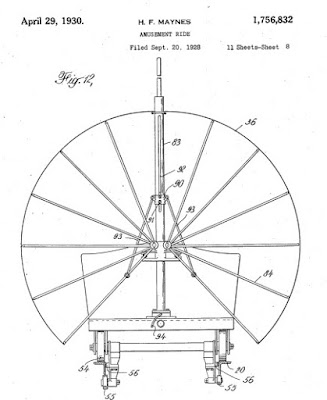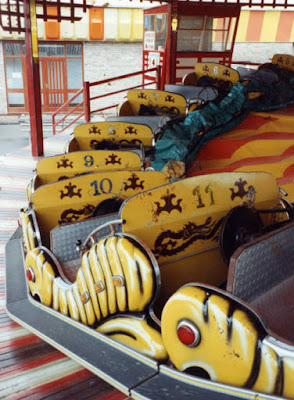Mulan was a Caterpillar ride at Pleasure Beach. When it closed on 4 November 2019, so ended its 29 seasons of operation at Pleasure Beach - one of the longest runs a ride has had during the park's long history. Let's take a look at the history and operation of this popular ride.
 |
| Mulan at Pleasure Beach in 2011. |
The first Caterpillar ride opened in 1925 at Coney Island in Brooklyn. This ride, and its successors consist of a circular undulating track on which coupled cars travel at high speed. This provides a high level on centrifugal force, and riders sat on the outside are squashed by riders sat on the inside. To provide riders' additional thrill, the ride's inventor, Hyla F. Maynes, devised a collapsible canopy that could be extended to cover the cars during the ride cycle. Maynes patented his ride designs and the term Caterpillar was quickly attached to such rides in response to how the ride looks with the (usually green) canopy extended over the cars.
 |
| A couple on the Coney Island Caterpillar in 1925. |
 |
| Image from Maynes patent, showing his design for covering cars with a canopy during the ride. |
From 1980, German ride manufacturer Mack GmbH & Co KG (known today at Mack Rides) built several trailer-mounted Caterpillar rides intended for travelling fairgrounds. The ride measures 60ft (18.5m) in diameter when set up, with a tall canopy. The circular track has three undulations - a wide shallow one at the front to assist loading, and two shorter, steeper ones at the back. They can seat up to 60 riders in twenty cars (20x3) and have a top speed of 14rpm in both forward and reverse directions. All the cars were built to resemble caterpillars, per the classic name. They all originally featured a fabric back-flash and a green fabric canopy was used to cover the cars part-way through the ride. One went to Albert and Christa Aigner, who named it Die Raupe (German for The Caterpillar) and toured Germany with it from 1981 until 1990. It was then sold to Botton Brothers, which was the company operating Pleasure Beach at the time, where it was installed for 1991 season.
 |
| die Raupe - the Caterpillar, as operated by the Aigner's. |
 |
| The ride at Pleasure Beach in 1993. Reproduced with permission of the University of Sheffield. |
 |
| Some of the ride's cars. Reproduced with permission of the University of Sheffield. |
Initially, it operated in the centre of the park, south of the Dodgems, but it was moved nearer the entrance to the park for the 1997 season. The ride proved instantly popular, and even made appearances at the Hull Fair from time-to-time before the season at Pleasure Beach was extended in 2001. Several modifications were made to the ride during its time at Pleasure Beach. In terms of design and operation, these include:
+ The back-flash was never installed
+ The ticket booth was never used, as operators or attendants check payment on the steps
+ The steps were removed and fences added along the front section of the ride together with entrance and exit gates - a more suitable setup for operation in an amusement park setting
+ Following the release of Disney's Mulan in 1998, the ride was rethemed with characters from the film, renamed Mulan and a new top sign with this name was installed
+ Following the release of Disney's Mulan in 1998, the ride was rethemed with characters from the film, renamed Mulan and a new top sign with this name was installed
+ The lighting was updated to LEDs in 2015
+ The ride's maximum capacity was restricted to 40 (20x2)
+ Reverse was disabled, aside from step 1, which was to assist stopping the ride.
Unlike modern rides, many of which are computer controlled, with fixed cycles and sometimes nothing more than the push of a button required; this ride was connected through the various controls directly to the operator, who could determine the speed, duration and intensity of the ride. As a ride operator, you would get a real sense of feeling that you had contributed to the enjoyable experience which riders had. From a maintenance point of view, it was a reliable ride that could often be fixed with simple tools and parts, and down-time was very low as a result.
+ Reverse was disabled, aside from step 1, which was to assist stopping the ride.
Unlike modern rides, many of which are computer controlled, with fixed cycles and sometimes nothing more than the push of a button required; this ride was connected through the various controls directly to the operator, who could determine the speed, duration and intensity of the ride. As a ride operator, you would get a real sense of feeling that you had contributed to the enjoyable experience which riders had. From a maintenance point of view, it was a reliable ride that could often be fixed with simple tools and parts, and down-time was very low as a result.
Whilst once very common rides at travelling fairs and static amusement parks, most original rides were dismantled and few examples remain. In the UK, Caterpillar rides can be found at the Scarborough Fair Collection and Folly Farm Adventure Park and Zoo. Visually similar rides called Music Express are common at travelling fairs in the UK and Europe. These rides offer a similar experience to Caterpillars. Although they do not feature a canopy covering riders during the cycle, they can offer an entertaining ride as the operators usually adjust the speed and direction of the ride according to the tempo of the music they play.
 | |
|
After 29 seasons at Pleasure Beach, near the end of 2019 season, it was announced Mulan had been sold and would be relocated to Italy, to be replaced by a new ride the following year. A business cannot afford to be sentimental. As a small amusement park competing for its share of a competitive market, I understand why it would take advantage of limited opportunities to develop. Nevertheless, the ride will be missed by visitors and staff alike


No comments:
Post a Comment